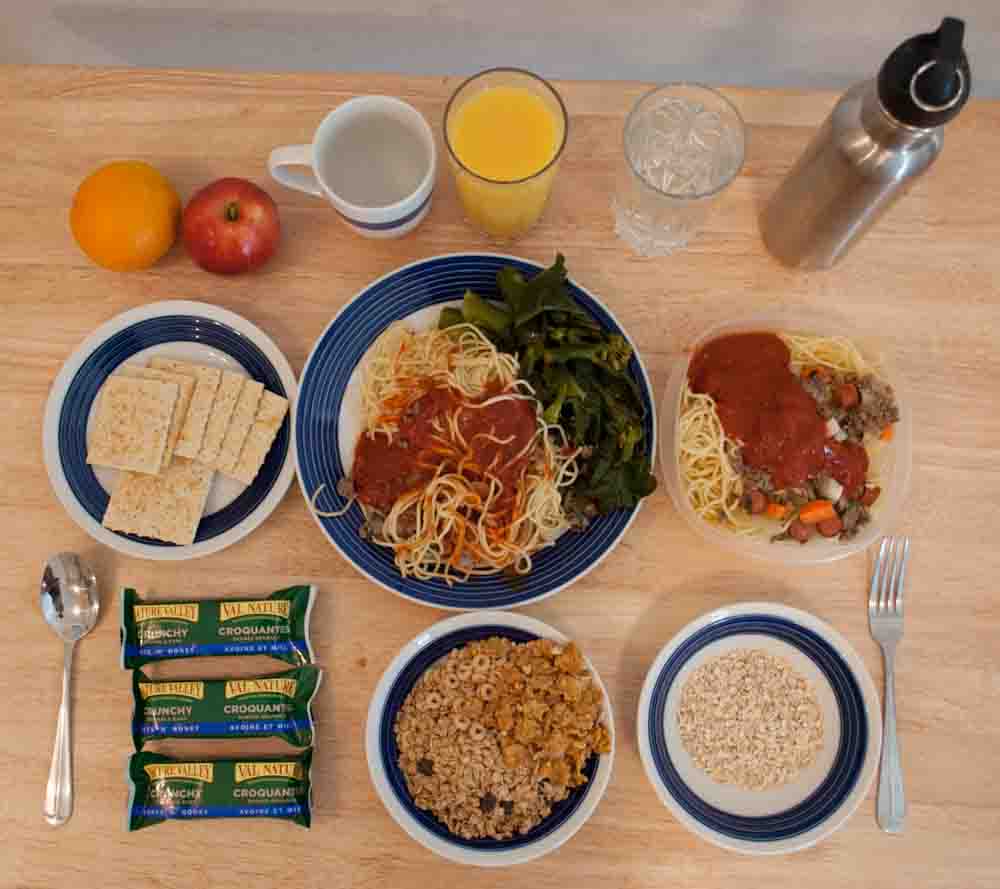Welcome to UBC Blogs. This is your first post. Edit or delete it, then start blogging!
The oil we eat
This is a picture of all the food I ate yesterday; here is a summary of the role of oil in production, packaging, and delivery. How oil factors into what we eat is an important part of determining our environmental footprint.
Breakfast, in the lower left consists of rolled oats that, with a cup of water, is heated to make porridge that is mixed with a bowl of dry cereal. Throughout the day 3 granola bars, some crackers, an orange, and an apple are eaten for snack. Lunch and dinner consists of pasta with vegetables and ground beef. A glass of orange juice is consumed at dinner.
To begin, it is easiest to work backwards from the kitchen table. Living in Fort Providence, all goods except the water was purchased 320km away in Yellowknife before being brought in. This is because Fort Providence does not have local food except for fishing and the general store has a limited selection. There is a water treatment plant in Fort Providence which uses chlorination and is distributed by truck. Pipelines in this region of Canada do not exist because of the cost and the danger of damage due to freeze-thaw cycles. Everything coming into Yellowknife is shipped through Edmonton which is 1500 km away.
The porridge comes from a paper sack and everything else is package in some form of plastic except for the pasta sauce which comes in a jar. The snacks come in cardboard boxes. It’s worth noting that the packaging of all the products shown are only a portion of the bought goods. For example, apples and oranges come in bags and the granola bars come in a box of 64. Creating plastic is an energy intensive process; however, it is necessary to maintain the freshness and edibility of the products being shipped from such a distance. the cardboard and glass are also fairly energy intensive but make use of recycled material thus, theoretically, requiring less extraction from primary resources.
The ground beef is from the Edmonton region, taking alberta beef and processing it extensively to produce ground beef from the less desirable parts of a cow. The cereals and spaghetti pasta come from Mississauga Ontario the processing plants exist to package the product. The raw wheat is most likely from Saskatchewan farms. In all cases, the processing plants would have used significant energy to process the wheat into the product with the addition of flavourings and chemicals to prolong shelf life. The wheat, like the vegetables and fruit, would have been grown on industrial sized farms using industrial tractors, fertilizes, and pesticides.
Interestingly, the furthest distance of food is the apples, oranges, and granola bars that originate in California. This is because the climate of Califorina is more idea for agriculture with a longer growing season and less dynamic climate. Since the oranges and fruit are considered fresh fruit, it requires that they have the largest amounts of pesticides on them and the greatest genetic modifications.
While one may not agree with the process in which our food is made, there is an advantage to reducing the amount of time spent procuring food and allowing more time and energy for other activities such as work, school, or leisure. Similar to Manning’s thesis, our domestication of food sources from wheat to cattle has, while allowing us to improve our way of life through the green revolution, also succeeds in increasing our dependence on chemical fertilizers and transportation which, at it’s origins, is fossil fuels. Without indepth research beyond the scope of this blog post, it is difficult to determine the percentage of transportation, fertilizer, and processing in the production of each dinner table good. The transportation is without a doubt a incredible distance being in Fort Providence. Being in the South of Canada would reduce this transportation distance, however, being in Vancouver would still require goods to be transported from Ontario and California. The processing energy does not change with the source, but could use fewer fertilizers and processing chemicals.
Ultimately, to reduce our environmental footprint requires that we source of food from less processing intensive sources. This requires less ferlizer and processing chemicals as well as a shorter transportation distance. In much of Northern Canada this is impossible because there is no climate available to create farmland. While there is agriable land in Southern Canada, the tradeoff to the person is time and energy and the environment. We must make a choice on how much time and energy we devote to survival and how much energy is used to produce a good. I’ve chosen that survival should take minimal time and energy which has the consequence of an increased environmental impact. This requires that I find other ways to reduce my environmental impact. Those ways are still under examination and mostly include day to day alternatives such as reduced food waste, recycling, and composting.
This took so long to figure out and set up…
why… why is this so confusing…

